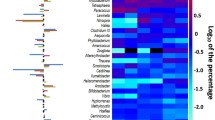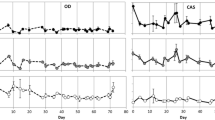Abstract
Bio-foaming is a major problem in solid separation in activated sludge (AS) wastewater treatment systems. Understanding the changes in bacterial communities during sludge foaming is vital for explaining foam formation. Changes in bacterial communities in the foam, corresponding foaming AS, and non-foaming AS in a seasonal foaming wastewater treatment plant (WWTP) in Northern China were investigated by high-throughput pyrosequencing and molecular quantification-based approaches. We found that bacterial communities of the foam and the corresponding foaming AS were similar but markedly different from those of the non-foaming AS. Actinobacteria was the predominant phylum in the foam and the corresponding foaming AS, whereas Proteobacteria was predominant in the non-foaming AS. Similar to the results of most previous studies, our results showed that Candidatus “Microthrix parvicella” was the predominant filamentous bacteria in the foam and the corresponding foaming AS and was significantly enriched in the foam compared to the corresponding foaming AS. Its abundance decreased gradually with a slow disappearance of sludge foaming, indicating that its overgrowth had a direct relationship with sludge foaming. In addition to Candidatus M. parvicella, Tetrasphaera and Trichococcus might play a role in sludge foaming, because they supported the changes in AS microbial ecology for foam formation. The effluent water quality of the surveyed plant remained stable during the period of sludge foaming, but the microbial consortia responsible for nitrogen and phosphorus transformation and removal markedly changed compared to that in the non-foaming AS. This study adds to the previous understanding of bacterial communities causing foaming in WWTPs.





Similar content being viewed by others
References
Ye L, Zhang T (2013) Bacterial communities in different sections of a municipal wastewater treatment plant revealed by 16S rDNA 454 pyrosequencing. Appl Microbiol Biotechnol 97:2681–2690
Frigon D, Michael Guthrie R, Timothy Bachman G, Royer J, Bailey B, Raskin L (2006) Long-term analysis of a full-scale activated sludge wastewater treatment system exhibiting seasonal biological foaming. Water Res 40:990–1008
Pujol R, Duchene P, Schetrite S, Canler J (1991) Biological foams in activated sludge plants: characterization and situation. Water Res 25:1399–1404
Seviour E, Williams C, Seviour R, Soddell J, Lindrea K (1990) A survey of filamentous bacterial populations from foaming activated sludge plants in eastern states of Australia. Water Res 24:493–498
Guo F, Wang ZP, Yu K, Zhang T (2015) Detailed investigation of the microbial community in foaming activated sludge reveals novel foam formers. Sci Rep 5
Slijkhuis H (1983) Microthrix parvicella, a filamentous bacterium isolated from activated sludge: cultivation in a chemically defined medium. Appl Environ Microbiol 46:832–839
Shen FT, Huang HR, Arun A, Lu HL, Lin TC, Rekha P, Young CC (2007) Detection of filamentous genus Gordonia in foam samples using genus-specific primers combined with PCR-denaturing gradient gel electrophoresis analysis. Can J Microbiol 53:768–774
Marsh TL, Liu WT, Forney LJ, Cheng H (1998) Beginning a molecular analysis of the eukaryal community in activated sludge. Water Sci Technol 37:455–460
Blackall LL, Burrell PC, Gwilliam H, Bradford D, Bond PL, Hugenholtz P (1998) The use of 16S rDNA clone libraries to describe the microbial diversity of activated sludge communities. Water Sci Technol 37:451–454
Erhart R, Bradford D, Seviour RJ, Amann R, Blackall LL (1997) Development and use of fluorescent in situ hybridization probes for the detection and identification of ‘Microthrix parvicella’ in activated sludge. Syst Appl Microbiol 20:310–318
Seviour RJ, Kragelund C, Kong Y, Eales K, Nielsen JL, Nielsen PH (2008) Ecophysiology of the Actinobacteria in activated sludge systems. Antonie Van Leeuwenhoek 94:21–33
Lechevlier MP, Lechevalier H (1974) Nocardia amarae sp. nov., an actinomycete common in foaming activated sludge. Int J Syst Bacteriol 24:278–288
Wang J, Li Q, Qi R, Tandoi V, Yang M (2014) Sludge bulking impact on relevant bacterial populations in a full-scale municipal wastewater treatment plant. Process Biochem 49:2258–2265
Eikelboom DH (2000) Process control of activated sludge plants by microscopic investigation. IWA publishing, London, pp 85–102
Khan MA, Mohsin J, Faheem SM (2013) Monitoring microbial diversity of a full-scale municipal wastewater treatment plant in Dubai. APCBEE Proc 5:102–106
State Environmental Protection Administration of China (2002) Standard methods of water and wastewater monitoring. 4th ed
Amann RI, Krumholz L, Stahl DA (1990) Fluorescent-oligonucleotide probing of whole cells for determinative, phylogenetic, and environmental studies in microbiology. J Bacteriol 172:762
Daims H, Bruhl A, Amann R, Schleifer KH, Wagner M (1999) The domain-specific probe EUB338 is insufficient for the detection of all bacteria: development and evaluation of a more comprehensive probe set. Syst Appl Microbiol 22:434–444
Kragelund C, Müller E, Schade M, Nguyen H, Lemmer H, Seviour RJ, Nielsen PH (2009) FISH handbook for biological wastewater treatment. IWA publishing, London, pp 73–84
Lane D (1991) 16S/23S rRNA sequencing. Nucleic acid techniques in bacterial systematics. 125–175
Haas BJ, Gevers D, Earl AM, Feldgarden M, Ward DV, Giannoukos G, Ciulla D, Tabbaa D, Highlander SK, Sodergren E (2011) Chimeric 16S rRNA sequence formation and detection in Sanger and 454-pyrosequenced PCR amplicons. Genome Res 21:494–504
Pruesse E, Quast C, Knittel K, Fuchs BM, Ludwig W, Peplies J, Glöckner FO (2007) SILVA: a comprehensive online resource for quality checked and aligned ribosomal RNA sequence data compatible with ARB. Nucleic Acids Res 35:7188–7196
Guo F, Zhang T (2012) Profiling bulking and foaming bacteria in activated sludge by high throughput sequencing. Water Res 46:2772–2782
Schloss PD, Westcott SL, Ryabin T, Hall JR, Hartmann M, Hollister EB, Lesniewski RA, Oakley BB, Parks DH, Robinson CJ (2009) Introducing mothur: open-source, platform-independent, community supported software for describing and comparing microbial communities. Appl Environ Microbiol 75:7537–7541
Edgar RC, Haas BJ, Clemente JC, Quince C, Knight R (2011) UCHIME improves sensitivity and speed of chimera detection. Bioinformatics 27:2194–2200
Klammer S, Knapp B, Insam H, Dell’Abate MT, Ros M (2008) Bacterial community patterns and thermal analyses of composts of various origins. Waste Manag Res 26:173–187
De Gregoris TB, Aldred N, Clare AS, Burgess JG (2011) Improvement of phylum- and class-specific primers for real-time PCR quantification of bacterial taxa. J Microbiol Methods 86:351–356
Ritalahti KM, Amos BK, Sung Y, Wu Q, Koenigsberg SS, Löffler FE (2006) Quantitative PCR targeting 16S rRNA and reductive dehalogenase genes simultaneously monitors multiple dehalococcoides strains. Appl Environ Microbiol 72:2765–2774
Bjornsson L, Hugenholtz P, Tyson GW, Blackall LL (2002) Filamentous Chloroflexi (green non-sulfur bacteria) are abundant in wastewater treatment processes with biological nutrient removal. Microbiology 148:2309–2318
Weber CF, King GM (2010) Quantification of Burkholderia coxL genes in Hawaiian volcanic deposits. Appl Environ Microbiol 76:2212–2217
Kaetzke A, Jentzsch D, Eschrich K (2005) Quantification of Microthrix parvicella in activated sludge bacterial communities by realtime PCR. Lett Appl Microbiol 40:207–211
VandeWalle J, Goetz G, Huse S, Morrison H, Sogin M, Hoffmann R, Yan K, McLellan S (2012) Acinetobacter, Aeromonas and Trichococcus populations dominate the microbial community within urban sewer infrastructure. Environ Microbiol 14:2538–2552
Klein AN, Frigon D, Raskin L (2007) Populations related to Alkanindiges, a novel genus containing obligate alkane degraders, are implicated in biological foaming in activated sludge systems. Environ Microbiol 9:1898–1912
Sokal RR, Rohlf FJ (1995) Biometry. The principles and practice of statistics in biology research. Biometry the principles & practice of statistics in biological research
Legendre P, Legendre L (2012) Developments in numerical ecology. Springer, Berlin
Xu M, Wu WM, Wu L, He Z, Nostrand JDV, Deng Y, Luo J, Carley J, Ginder-Vogel M, Gentry TJ (2010) Responses of microbial community functional structures to pilot-scale uranium in situ bioremediation. ISME J 4:1060–1070
Van Etten E (2005) Multivariate analysis of ecological data using canoco. Aust Ecol 30:486–487
Levantesi C, Rossetti S, Thelen K, Kragelund C, Krooneman J, Eikelboom D, Nielsen PH, Tandoi V (2006) Phylogeny, physiology and distribution of Candidatus ‘Microthrix calida’, calida’, a new microthrix species isolated from industrial activated sludge wastewater treatment plants. Environ Microbiol 8:1552–1563
Petrovski S, Tillett D, Seviour RJ (2012) Isolation and complete genome sequence of a bacteriophage lysing Tetrasphaera jenkinsii, a filamentous bacteria responsible for bulking in activated sludge. Virus Genes 45:380–388
Nielsen PH, Kragelund C, Seviour RJ, Nielsen JL (2009) Identity and ecophysiology of filamentous bacteria in activated sludge. FEMS Microbiol Rev 33:969–998
Wang J, Qi R, Liu M, Li Q, Bao H, Li Y, Wang S, Tandoi V, Yang M (2014) The potential role of Candidatus ‘Microthrix parvicella’ in phosphorus removal during sludge bulking in two full-scale enhanced biological phosphorus removal plants. Water Sci Technol 70:367–375
Heylen K (2006) Cultivation of denitrifying bacteria: optimization of isolation conditions and diversity study. Appl Environ Microbiol 72:2637–2643
Martín HG, Ivanova N, Kunin V, Warnecke F, Barry KW, McHardy AC, Yeates C, He S, Salamov AA, Szeto E (2006) Metagenomic analysis of two enhanced biological phosphorus removal (EBPR) sludge communities. Nat Biotechnol 24:1263–1269
Zhang T, Shao MF, Ye L (2012) 454 pyrosequencing reveals bacterial diversity of activated sludge from 14 sewage treatment plants. ISME J 6:1137–1147
Ju F, Guo F, Ye L, Xia Y, Zhang T (2014) Metagenomic analysis on seasonal microbial variations of activated sludge from a fullscale wastewater treatment plant over 4 years. Environ Microbiol Rep 6:80–89
Hu M, Wang X, Wen X, Xia Y (2012) Microbial community structures in different wastewater treatment plants as revealed by 454- pyrosequencing analysis. Bioresour Technol 117:72–79
Hug T, Ziranke M, Siegrist H (2005) Dynamics of population and scumming on a full-scale wastewater treatment plant in Switzerland. Acta Hydrochim Hydrobiol 33:216–222
Wong MT, Mino T, Seviour RJ, Onuki M, Liu WT (2005) In situ identification and characterization of the microbial community structure of full-scale enhanced biological phosphorous removal plants in Japan. Water Res 39:2901–2914
Kong Y, Xia Y, Nielsen JL, Nielsen PH (2007) Structure and function of the microbial community in a full-scale enhanced biological phosphorus removal plant. Microbiology 153:4061–4073
Jenkins D (1992) Towards a comprehensive model of activated sludge bulking and foaming. Water Sci Technol 25:215–230
Nielsen PH, Roslev P, Dueholm TE, Nielsen JL (2002) Microthrix parvicella, a functional lipid consumer in anaerobic-aerobic activated sludge plants. Water Sci Technol 46:73–80
de los Reyes FL III, Raskin L (2002) Role of filamentous microorganisms in activated sludge foaming: relationship of mycolata levels to foaming initiation and stability. Water Res 36:445–459
Pitt P, Jenkins D (1990) Causes and control of Nocardia in activated sludge. Res J Water Pollut Control Fed 62:143–150
Rossetti S, Tomei MC, Nielsen PH, Tandoi V (2005) “Microthrix parvicella”, a filamentous bacterium causing bulking and foaming in activated sludge systems: a review of current knowledge. FEMS Microbiol Rev 29:49–64
Andreasen K, Nielsen PH (2000) Growth of Microthrix parvicella in nutrient removal activated sludge plants: studies of in situ physiology. Water Res 34:1559–1569
Mcilroy SJ (2013) Metabolic model for the filamentous Candidatus ‘Microthrix parvicella’ based on genomic and metagenomic analyses. ISME J 7:1161–1172
Mielczarek AT, Saunders AM, Larsen P, Albertsen M, Stevenson M, Nielsen JL, Nielsen PH (2013) The microbial database for Danish wastewater treatment plants with nutrient removal (MiDas-DK) a tool for understanding activated sludge population dynamics and community stability. IWA World Water Congress, London, pp 84–87
Acknowledgments
This work was supported by the Main Direction Program of Knowledge Innovation of Chinese Academy of Sciences (No. KZCX2-YW-JC407-2) and the Strategic Priority Research Program (B) of the Chinese Academy of Sciences (XDB15010200). We would like to thank the staffs in the investigated WWTP for sampling.
Author information
Authors and Affiliations
Corresponding author
Rights and permissions
About this article
Cite this article
Wang, P., Yu, Z., Zhao, J. et al. Seasonal Changes in Bacterial Communities Cause Foaming in a Wastewater Treatment Plant. Microb Ecol 71, 660–671 (2016). https://doi.org/10.1007/s00248-015-0700-x
Received:
Accepted:
Published:
Issue Date:
DOI: https://doi.org/10.1007/s00248-015-0700-x




